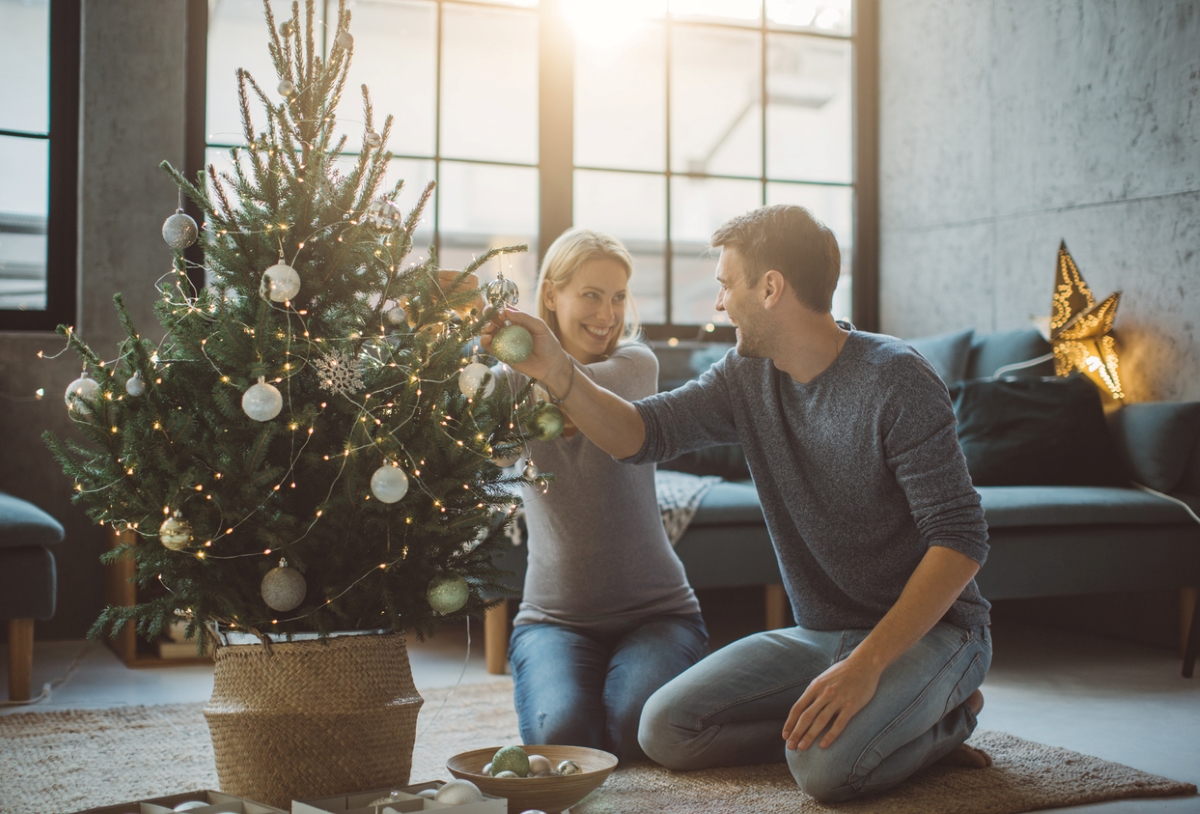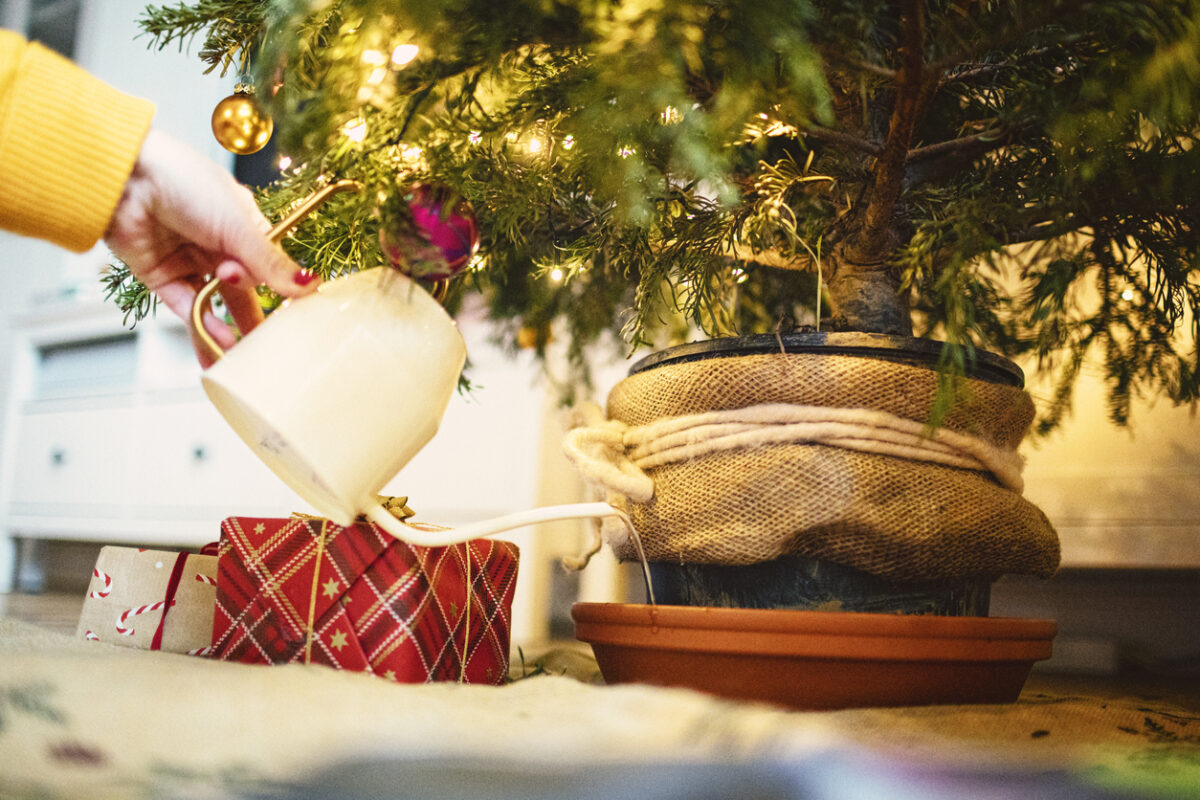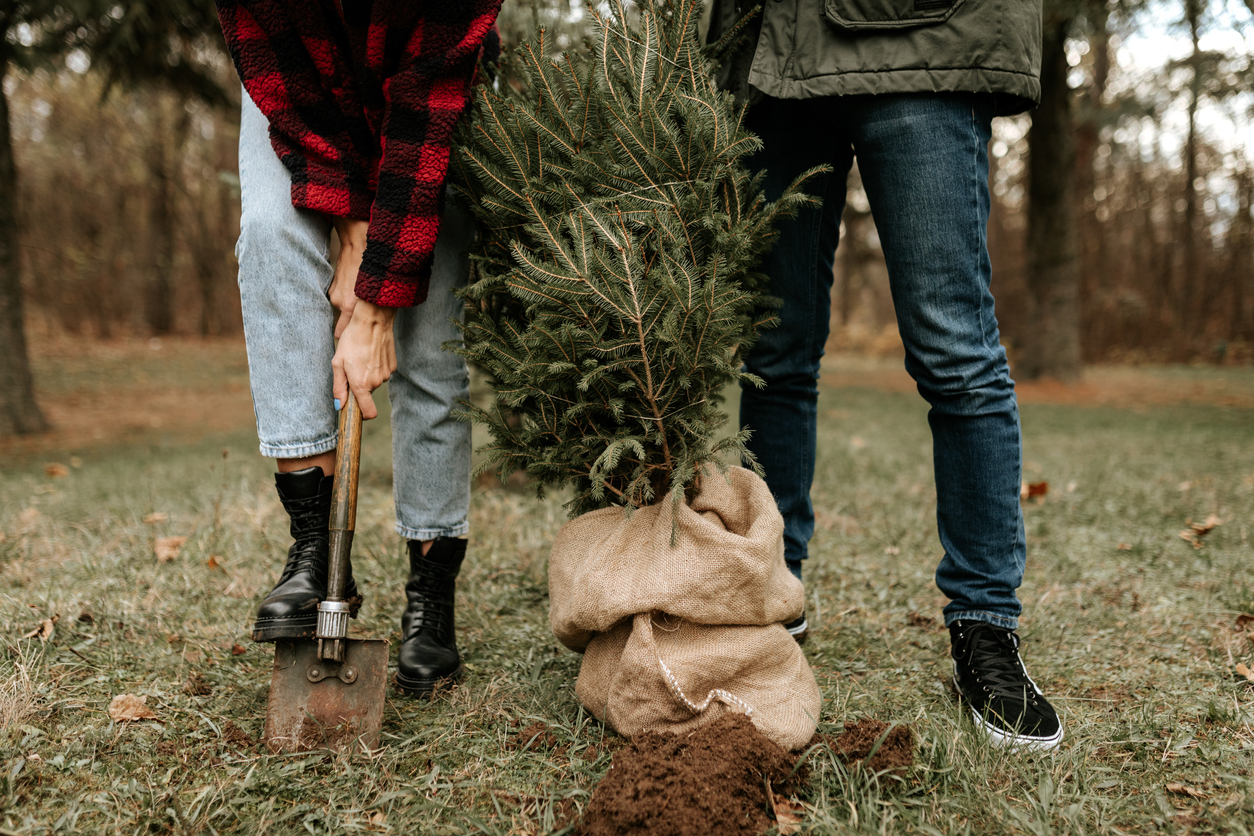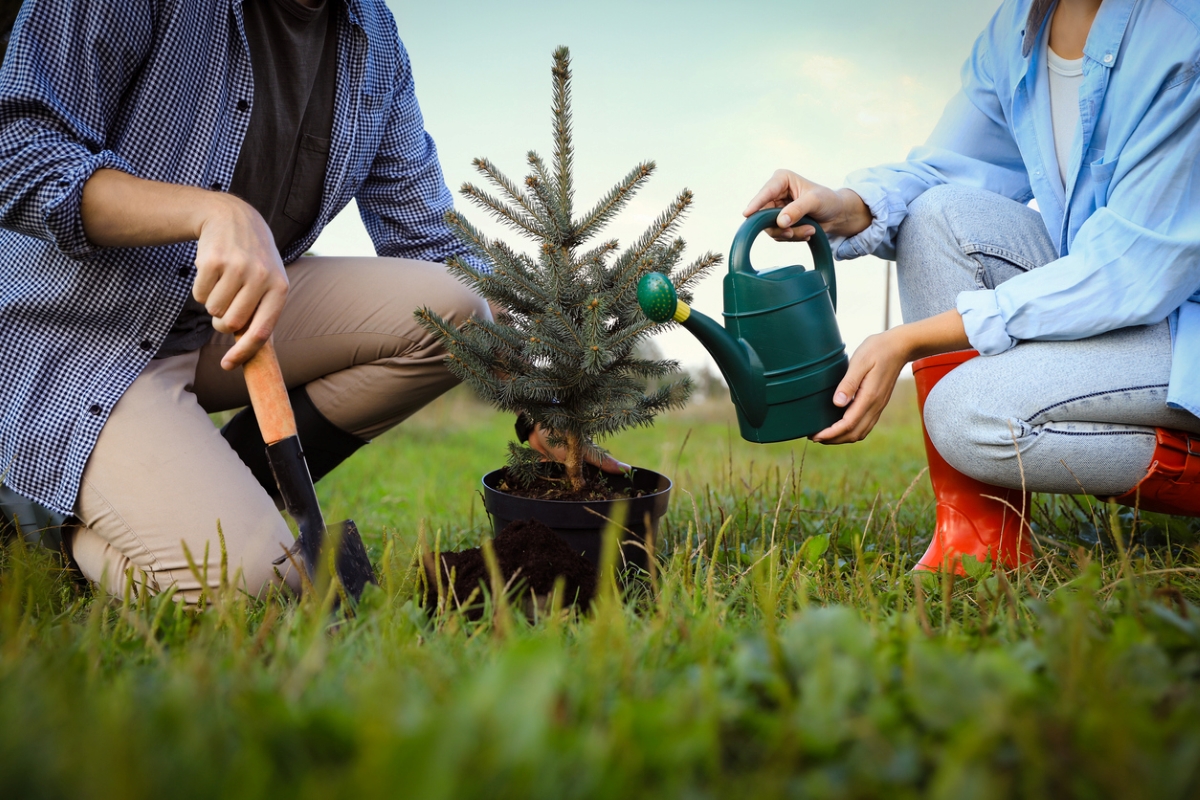

We may earn revenue from the products available on this page and participate in affiliate programs. Learn More ›
Every holiday season, the debate over cut or artificial Christmas trees resurfaces. Both options have their pros and cons, even as some of the best artificial Christmas trees have improved in terms of realism. But the true winner when it comes to sustainability and beauty is a living Christmas tree—specifically, one that still has its roots intact when you bring it home. Local nurseries around the country offer the option of buying a potted living tree. Stephanie Mack, tree buyer for Portland Nursery in Oregon, says, “A lot of folks choose native trees and plant the tree out after the holidays are over.” If you aren’t up for planting a tree, dwarf living Christmas trees can remain in a container for several years and be brought inside just for the holiday.
According to the National Christmas Tree Association, consumers purchased 22.34 million real Christmas trees in 2022. Of these, 30 percent were purchased at choose-and-cut farms and about 60 percent were bought at other nonprofit and retail lots, including nurseries and chain stores. While a real tree, whether purchased at a lot or a cut-it-yourself farm, is somewhat counterintuitively more ecologically sustainable than an artificial tree, what all cut trees share is that they are used only once and then either disposed of or recycled.
What is a living Christmas tree?

Living Christmas trees are live trees with their roots still attached. They are typically sold either in containers or with their roots “balled and burlapped,” which means that the root ball of the dug-up tree has been bundled up in burlap or another fabric to allow for later replanting. Larger, faster growing trees like Douglas firs and true cypresses can stay in a container for only the short term (2 years or less) before being repotted or (ideally) planted; dwarf trees and some slower growing conifers can remain in containers for the long term (2 years or more).
Pros and Cons of Living Christmas Trees
Pros:
- A potted dwarf tree can be used for more than one Christmas. Just keep it outdoors in its container, and “bring it in and decorate” right before the holiday, says Mack.
- Living trees can be sturdier than cut trees.
- When planted outside, living trees offer lasting benefits for wildlife as well as carbon sequestration to help reduce emissions.
- When planted trees mature, they provide shade for the home or outdoor living areas.
- Long-term potted trees can be repotted when they outgrow their containers.
Cons:
- Living Christmas trees require care and water throughout winter (and their lives).
- A living tree should remain indoors for only a week or so over the Christmas season.
- Selecting a living tree requires some consideration and planning, as is the case with any plant you planting on your property.
How to Choose a Living Christmas Tree

When it’s time to find the perfect living tree for the holidays, it is important to consider space constraints, species, and the best time and place to buy a living Christmas tree.
Step 1: Determine what kind of space you have for the tree indoors (and on your property, if you’ll plant the tree later).
As with any Christmas tree, consider how much space the tree will require in the house. For apartments or small spaces, potted dwarf trees are good options because they bring in the scent and feel of a live tree but occupy a small footprint. With living trees, however, unlike with cut trees, you will also need to figure out where the tree will go after the holidays. “Make sure it’s the right plant for the right place,” says Mack.
If you intend to plant your living Christmas tree, choose only trees that will fit comfortably in your yard once they’re mature, cautions Bert Cregg, a professor of horticulture and forestry at Michigan State University. “Many pines, spruces, and firs sold as living Christmas trees can grow 2 feet or more per year once established and can quickly outgrow a small city lot,” he says. If you don’t have room in your landscaping or don’t want to bother with planting your tree, another option is to enjoy the tree for a year or two in its container and then gift it to a local school, church, or community center where it will have room to spread and can be enjoyed by others.
RELATED: How to Make Your Christmas Tree Last All Season
Step 2: Choose the species with the best chance of surviving in your climate.
Shoppers can be overwhelmed when it comes to deciding which Christmas tree species to purchase. Generally, sticking to native varieties is the best bet.
“Make sure to get one that will survive in your climate,” says Mack. One way to ensure a good match is to shop at “a tree farm, landscape nursery, or garden center,” says Cregg. These outlets are more likely to stock trees that thrive in the region, and the staff will have knowledge of species typical for the area. “Just like any other purchase for the landscape, the plant tag should indicate the USDA hardiness zone for the tree,” says Cregg. He adds that you should select a tree that can survive in a region at least as cold as your growing zone.
Popular species that are among the best types of Christmas trees for planting include: Douglas fir for Western states like Oregon; balsam fir in Southeastern Canada and the Northeastern U.S.; Fraser fir for the Appalachian Mountains region; Scotch pine in the Northeast, Great Lakes region, Central U.S., and Pacific Northwest; and Colorado blue spruce for the Western U.S. Portland Nursery publishes a helpful list of trees, including dwarf conifers.
Step 3: Time the purchase well, and pick a healthy tree.
Bring home a potted Christmas tree at least 1 week before you plan to move it indoors, but don’t bring it home too early. A living tree can’t, for instance, be set up and decorated over Thanksgiving weekend. “You can only have it in the house for 7 to 10 days,” says Mack, because the indoor heat and lack of humidity make the tree go into a kind of shock. Cregg points out that conifers can lose their cold hardiness if they’re indoors too long. “If they spend a month in a 70-degree house and are placed outside in 0-degree weather, they can suffer freeze damage, or even be killed,” he says.
Living Christmas trees can be purchased at plant nurseries, garden stores, and home improvement centers like The Home Depot, Lowe’s, and Ace Hardware. Experts recommend selecting trees with healthy-looking needles and avoiding those with yellow or brown tips. The needles should also be full, firm, and not easily plucked. Finally, look for trees with well-developed root balls and healthy branches. Although you can purchase tabletop Christmas trees online, if the tree will be planted in the yard, it’s best to buy from a local store where you “can talk to someone who knows the local climate and soils, and can help you match the tree to your site,” says Cregg.
RELATED: The Best Places to Buy Christmas Trees
How to Care for a Living Christmas Tree Indoors

Here’s how to keep a living tree thriving from the day you bring it home until the end of the holiday season.
Step 1: Keep the tree in a protected, cool spot before bringing it indoors.
Both Mack and Cregg recommend keeping a potted living tree in a sheltered spot, such as an outdoor porch, until the holiday is closely approaching. Mack tells customers to go ahead and put lights on if they like while the tree waits outside.
Step 2: Shake the tree before setting it up for the holiday.
Before bringing the tree indoors, shake it vigorously to help prevent Christmas tree pests from making it inside. Inspect the tree for aphids, adelgids, bark beetles, mites, spiders, and other bugs. If pests are found, treat the tree with a natural pesticide like diatomaceous earth.
Step 3: Water the tree regularly.
Even before setting up your living tree for the holiday, be sure to water it regularly. Once it’s inside, give the tree consistent moisture. “Watering with ice cubes is a good way to do that,” says Mack. The cubes melt slowly, releasing water at a consistent rate without overwatering.
Step 4: Find a cool indoor location for the tree.
Once it’s indoors, place the tree in a cool location, if possible, away from heat vents, wood stoves, and heaters. The tree should get some natural sunlight, but avoid placing it in a sunny window. It’s also a good idea to run a humidifier to help cool and moisten the air in the room.
Step 5: Avoid hanging heavy ornaments on a living tree.
Be gentle when hanging ornaments and lights on the Christmas tree. Avoid placing heavy ornaments on branches that could get damaged by the weight, and use small, low-temperature LED Christmas lights instead of older, heat-generating incandescent bulbs.
Step 6: Move the tree back to a cool spot after no more than 10 days inside.
This is a critical step, especially in colder climates, says Cregg. Return the tree to the porch or another unheated but protected spot like a garage until the weather warms up enough to plant the tree outside. Remember to continue watering it consistently.
How to Plant a Living Christmas Tree Outdoors

When the holiday is over and the decorations have been removed, it’s time to find a good spot outdoors for the plantable (or potted) Christmas tree. Wait until the tree has spent at least a few days in a protected spot, such as a porch or an unheated garage, acclimating to the cold. If you’re keeping a potted tree, just move it to a place with some shelter from the wind, such as a covered porch. But if you plan to plant the tree, you have some work to do.
Step 1: Choose an appropriate planting site.
Make sure the tree will fit in its intended outdoor home once it reaches its mature height and spread. (This information should be on the plant tag.) Avoid placing a tree where its branches will eventually hit power lines or the roof of your house, for example. Make sure the spot gives the tree enough sunlight and adequate drainage. “Many conifers do not like wet feet, and planting them on a wet site could be a recipe for disaster,” says Cregg.
Step 2: Prepare a hole.
Those who live in regions where the ground freezes in winter have two options: Prepare ahead by digging a hole in the fall and covering it with mulch until planting, or wait to plant the tree until the ground softens in spring. “Most of the trees will be fine if they’re planted in spring,” says Mack. Whether you’re digging in fall or spring, the hole should be about as deep as the root ball (or container) and twice as wide.
Step 3: Protect the roots when transplanting the tree.
Living Christmas trees fare best with an adequate root ball. To survive transplanting, a 5-foot tree will ideally have a root ball of about 22 inches in diameter. Smaller root balls probably won’t provide enough moisture to keep the tree alive. The burlap wrapped around a living tree’s roots helps protect them during planting. Although some of the burlap can remain, it is best to remove any wrapping, especially plastic, before filling the hole. Removing the wrapping will also let you access the roots to gently tease or break them up. Once the tree has been placed in the hole, have someone hold the tree level while you fill the hole. The soil should be even with the top of the roots.

Step 4: Continue to water the tree regularly.
After planting, spread 2 to 3 inches of mulch over the ground to help keep in moisture and protect against cold weather. Water the entire planting hole well, then continue to water regularly. Mack says that in areas with more winter precipitation, people can forget to water their potted or planted trees. “We get dry cold, and so if it hasn’t rained for a few days or if the tree is under an eave, keeping track of watering is important, even in winter,” she says.
Step 5: Wait a year or two before fertilizing.
“Most landscape conifers can do well without fertilizer, especially right after planting,” says Cregg. He suggests waiting a year or two before fertilizing a transplanted living tree. Typically, the trees need just an annual application of an all-purpose, slow-release fertilizer.
RELATED: How Long Does a Christmas Tree Last?
Final Thoughts
To reap the eco-friendly benefits of a living Christmas tree, be sure to do the necessary research and preparation on the tree that’s right for you, and keep the tree watered. If you’re leaving a living tree in a container for the long term, water it regularly and fertilize it about once a year. When a dwarf tree begins to outgrow its container (if there’s less than 6 inches from root ball to container edge), repot it to a container that’s the next size up, using a container potting mix.
Finally, remember that these potted trees can get heavy. Opt for a dwarf tree for repeated indoor use, and consider keeping a purchased tree to the 4-foot range; otherwise, it may be too heavy to move around at home and into the ground come planting time.
